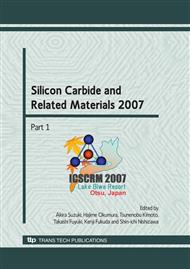p.557
p.563
p.567
p.571
p.575
p.579
p.585
p.591
p.597
Electronic Band Structure of Cubic Silicon Carbide Nanowires
Abstract:
In this work, the effects of the diameter and morphology on the electronic band structure of hydrogenated cubic silicon carbide (b-SiC) nanowires is studied by using a semiempirical sp3s* tight-binding (TB) approach applied to the supercell model, where the Si- and C-dangling bonds on the surface are passivated by hydrogen atoms. Moreover, TB results (for the bulk) are compared with density functional calculations in the local density approximation. The results show that though surface morphology modifies the band gap, the change is more systematic with the thickness variation. As expected, hydrogen saturation induces a broadening of the band gap energy because of the quantum confinement effect.
Info:
Periodical:
Pages:
575-578
Citation:
Online since:
September 2008
Authors:
Keywords:
Price:
Сopyright:
© 2009 Trans Tech Publications Ltd. All Rights Reserved
Share:
Citation:


